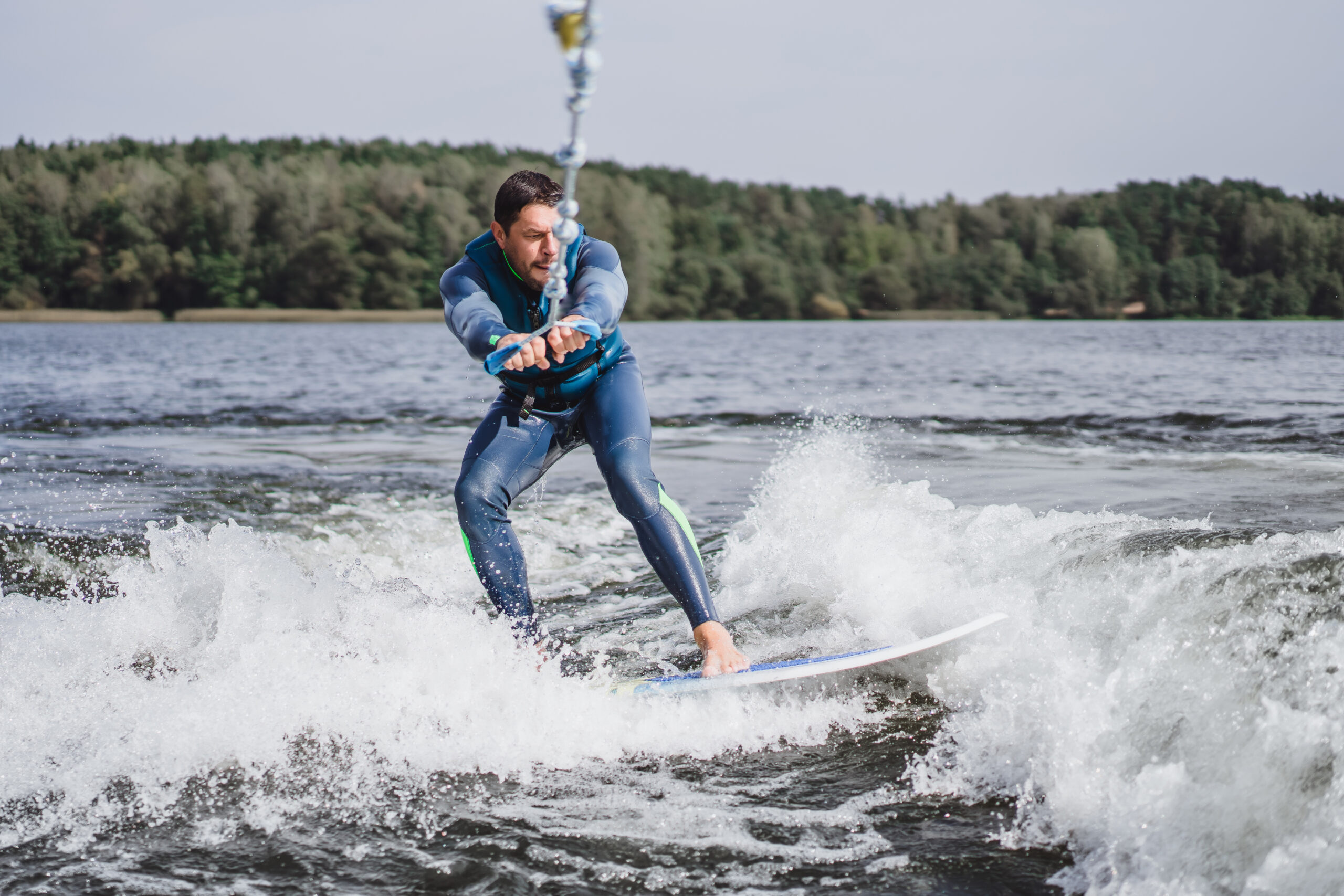
Wake boarding: A Detailed Guide to the Ultimate Water Sport
A fast-paced water sport that has become rather popular over years is wake boarding. Wakeboarding presents an unparalleled experience on the water, combining the freedom of surfing, the agility of snowboarding, and the thrills of water skiing. This thorough guide addresses all you need to know about Wake boarding, regardless of your experience with the sport or desire to advance your abilities.
What is wake boarding?
Wakeboarding is an intense water sport that involves riding on a wakeboard and being towed behind a boat. The rider executes different tricks, jumps, and manoeuvres using the wake the boat creates as it moves. Adrenaline junkies would find the sport ideal since it combines the acrobatic excitement of snowboarding with the fluidity of water skiing.
How effective is wake boarding?
The rider in wake surfing is tethered to the boat with a tow rope. The rider uses the boat’s wake—the waves it generates—to execute aerial manoeuvres while the ship pulls her across the water at a constant speed. To ride effectively and perform tricks, wake boarding calls for strength, balance, and timing.
Wake boarding’s essential tools
Having the correct gear will help to ensure a safe and fun Wake boarding experience before you set out on the lake. The gear you will need is broken out here in great detail:
| Equipment | Description | Purpose |
| Wakeboard | A specialized board used for Wake boarding, typically wider than a traditional surfboard. | Provides the platform for the rider to stand on while being towed behind the boat. |
| Bindings | Footwear that holds the rider’s feet securely to the wakeboard. | Ensures safety and control while performing tricks and maneuvers. |
| Tow Rope | A strong rope that connects the rider to the boat. | Allows the rider to be pulled by the boat at a controlled speed. |
| Life Jacket | A flotation device worn by the rider. | Provides buoyancy and ensures safety in the water. |
| Boat | The motorboat used to tow the rider across the water. | The source of the wake and the power to pull the rider at high speeds. |
Wakeboard Choice Advice
Your weight, skill level, and riding style all affect the wakeboard you choose. While advanced riders may want a smaller, more agile board to execute tricks, beginners typically select a more giant, more solid board.
Why Bindings Matter
Wakeboarding cannot exist without bindings. Their strong foothold on the board gives the rider the required control and support for trick performance. There are two primary varieties: open-toe and closed-toe bindings. While closed-toe bindings give better foot support and comfort for advanced riders, open-toe bindings are more flexible and simple to adjust.
Techniques in Wakeboarding
Beginners must learn the fundamental Wake boarding techniques. Here is a detailed road map for beginning:
1. Getting Into Position
- Start in the Water: To begin, hold the tow rope while lying on your back in the water. Keep your knees bent and your feet flat on the board.
- Hold the Tow Rope: Grip the rope with both hands, and keep the rope tensioned so that you are being pulled gently by the boat.
- Boat Speed: Initially, the boat should start at a slow speed. As you become comfortable, the driver can gradually increase the speed.
2. Standing Up
- Pull Up Slowly: As the boat accelerates, begin to pull your knees to your chest and slowly push up into a standing position.
- Maintain Balance: Once standing, keep your knees slightly bent to absorb any bumps and maintain balance. Your weight should be centered over the board.
3. Turning
- Initiate a Turn: To turn left or right, simply apply pressure to the edge of the board. Leaning slightly in the direction you want to go will create the necessary turning motion.
- Smooth Transitions: Always keep your movements smooth to maintain control over the board.
4. Jumping and Performing Tricks
- Use the Wake: The boat’s wake is essential for performing jumps and tricks. As you approach the wake, apply pressure to the back foot to lift yourself off the water.
- Aerial Tricks: As you get more confident, you can begin performing spins, flips, and other aerial tricks. Make sure to land with your knees bent to absorb the shock and maintain balance.
Advanced Wake boarding Tricks
Once you’ve mastered the basics, it’s time to explore more advanced tricks. Here are a few popular maneuvers to try:
| Trick Name | Description |
| 180° Spin | The rider rotates 180 degrees in the air, landing in the opposite direction. |
| Backflip | A flip performed by lifting off the wake and rotating backward. |
| Inverts | Tricks where the rider flips upside down mid-air. |
| Grabs | A trick where the rider grabs the board mid-air to add style to their jumps. |
Tips for Advanced Riders
- Build Strength and Flexibility: Wake boarding requires a great deal of core strength and flexibility. Regular strength training and stretching will help improve your performance.
- Practice Regularly: The key to mastering advanced tricks is practice. Consistency will help you improve over time.
- Focus on Technique: Always focus on proper technique to ensure that you are performing tricks safely and effectively.
Wake boarding Safety Tips
Wake boarding should always give safety first concern. Here are some safety pointers to keep in mind:
1. Own a life jacket
Safety depends on a well-fitting life jacket. It will support you should you fall and keep you afloat in the sea.
2. Apply a Spotter
Always have someone in the boat watching you and talking with the driver. This guarantees that the driver can adjust and offer help if necessary.
3. Know hand signals
Before diving in, make sure you understand the fundamental hand signals for wakeboarding. These signals let you talk with the boat driver without shouting.
4. Examine Your Toolkit
Before every session, check your gear for wear and tear. Make sure the boat is running correctly, the tow rope is in good shape, and your bindings are tight.
Popular Wake boarding Destinations
If you’re looking for the best places to practice Wake boarding, here are a few renowned locations:
| Destination | Location | Features |
| Lake Havasu | Arizona, USA | Known for its warm waters and vibrant community. |
| Cable Wake Park | Dubai, UAE | Offers a state-of-the-art cable system for all skill levels. |
| Antalya | Turkey | Ideal for both beginners and advanced riders, with clear waters. |
| Lake Balaton | Hungary | Europe’s largest lake, popular for Wake boarding. |
Conclusion
Wake boarding is an exciting and dynamic sport that offers endless opportunities for adventure. Whether you’re a beginner or an expert, the sport has something to offer. With the right equipment, techniques, and safety precautions, you can enjoy Wake boarding to the fullest. So grab your wakeboard, head to the water, and experience the thrill of Wake boarding today!
By following these guidelines and continuously practicing, you’ll be well on your way to mastering this exciting water sport.
FAQs about Wake boarding
1. What is Wakeboarding, and How Does it Work?
In wakeboarding, a rider stands on a wakeboard under tow from a boat. The boat generates waves or wakes, which the rider exploits for different tricks and manoeuvres. It’s an interesting and flexible sport that combines surfing, snowboarding, and water skiing.
2. Is a wake boarding call for special equipment needed?
Indeed, when learning wake boarding, you will need a wakeboard, bindings to fasten your feet, a tow rope, and a life jacket for safety. The boat you are using also has to be ready to produce a good wake for jumping and trick execution.
3. Is learning Wakeboarding challenging?
Although initially difficult, most beginners can pick up the foundations in a few sessions with the correct direction and practice. Before beginning tricks and jumps, perfect your stance and balance.
4. List Some Common Wakeboarding Techniques.
Although Wake boarding techniques abound, the 180° spin, backflip, and grabs are among the most often used. These techniques entail mid-flight acrobatic moves utilising the boat’s wake to acquire air.
5. Where Can I Go Wake boarding?
You can go Wake boarding in lakes, rivers, and specially designed cable parks. Popular destinations for Wake boarding include Lake Havasu in Arizona, Cable Wake Park in Dubai, and Lake Balaton in Hungary, which are known for their ideal conditions for the sport.



